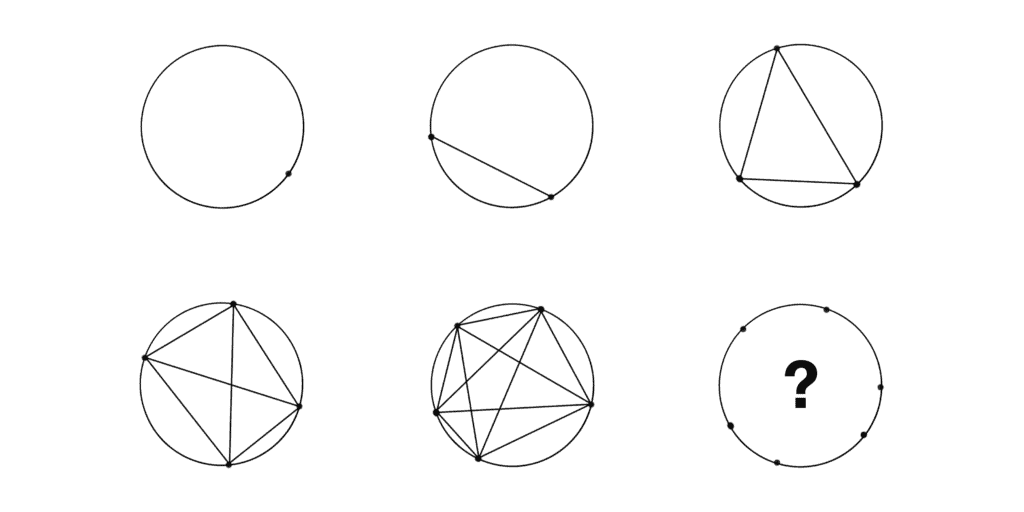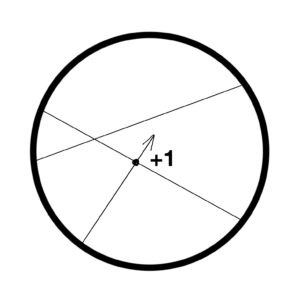Do Not Add E
Add a single letter at the end to create a meaningful word. You CANNOT add the letter E.
S E Q U E N C _
You should add the letter F above the underscore to create the letter E and get the word SEQEUNCE.
We do not know where this puzzle originated from. If you have any information, please let us know via email.
Add a single letter at the end to create a meaningful word. You CANNOT add the letter E.
S E Q U E N C _
You should add the letter F above the underscore to create the letter E and get the word SEQEUNCE.
Can you guess what the question mark should be replaced with? The answer is not 6.
| 1 | 3 | 5 |
| 2 | 4 | ? |
The missing symbol is R, as in a car’s gears.
You walk into a room where there are three mammals held in cages:
Which is the most intelligent mammal in the room?
The answer is… YOU.
If:
then BUCK → ?
The answer is CHICKEN.
RABBIT sounds like the noise a FROG makes, OWL sounds like the noise a WOLF makes, BEAR sounds like the noise a SHEEP makes, and MOOSE sounds like the noise a COW makes. Since BUCK sounds like the noise a CHICKEN makes, that’s the answer.
If you make a CORRECT statement, you will get either a lollipop or a chewing gum. If you make a FALSE statement, you will get either a chocolate or a car. What statement should you make in order to get the car?
You should say “I will receive a chocolate”. This statement cannot be correct, since if it was, you would get a lollipop or a chewing gum, not a chocolate. Therefore, you will get the car.
Can you find a triple of three-digit numbers that sum up to 999 and collectively contain all digits from 1 to 9 exactly once? How many such triples are there? What if the sum was 1000?
There are exactly 180 such triples that sum up to 999 and none that sum up to 1000.
In order to see that, notice that the sum of the first digits of the numbers can be no more than 9. Since the sum of all digits is 45, the sum of the middle and the sum of the last digits should be both no more than 9+8+7=24, and no less than 45-9-24=12. We then see that the sum of the last digits should be exactly 19 and the sum of the middle digits should be exactly 18. The sum of the first digits should be 45-19-18=8.
There are 2 ways to get 8 using unique digits from 1 to 9: 1+2+5 and 1+3+4.
Since the set of the first digits, the set of the middle digits, and the set of the last digits of the numbers can be permuted in 6 ways each, we get a total of 5×6×6×6=1080 solutions, or 180 up to permutation of the 3 three-digit numbers.
In order to see that we cannot get a sum of 1000, we note that since the sum of the digits from 1 to 9 is divisible by 9, then the sum of the 3 three-digit numbers should be divisible by 9 as well. Since 1000 is not divisible by 9, the statement follows.
There are N points on a circle. If we draw all the chords connecting these points and no three of them intersect at the same point, in how many parts will the interior of the circle get broken?
For example, when N is equal to 1, 2, 3, 4, and 5, we get 1, 2, 4, 8, and 16 parts respectively.

The answer, somewhat surprisingly, is not 2ᴺ⁻¹, but 1 + N(N-1)/2 + N(N-1)(N-2)(N-3)/24.
In order to see that, we start with a single sector, the interior of the circle, and keep successively drawing chords. Every time we draw a new chord, we increase the number of parts by 1 and then add 1 extra part for each intersection with previously drawn chords.

Therefore, the total number of parts at the end will be:
1 + the number of the chords + the number of the intersections of the chords
Each chord is determined by its 2 endpoints and therefore the number of chords is N(N-1)/2.
Each intersection is determined by the 4 endpoints of the two intersecting chords and therefore the number of intersections is N(N-1)(N-2)(N-3)/4!.
Please confirm you want to block this member.
You will no longer be able to:
Please allow a few minutes for this process to complete.